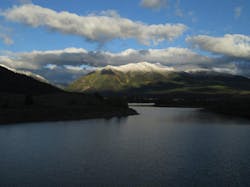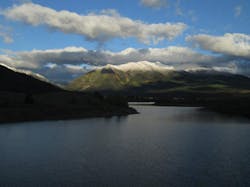Western Water Managers Move Towards Collaborative Approaches to Water Management
By Jonathan S. King
The completion of the state of Colorado’s Water Plan1 on November 19, 2015, reflects a growing trend in western water management away from conflict and towards collaborative and inclusive discussion. Increasingly, western water managers are opting, or perhaps feeling obliged, to pursue more creative and coordinated solutions to complex water issues, built on broad-based stakeholder participation.
Historically, western water management discussions have been a confrontational, divisive, and often exclusive affair. The 1922 Colorado River Compact, for example, which divided the Colorado River into an Upper and Lower Basin and provided for the allocation of water among seven U.S. basin states, was negotiated to the exclusion of a number of important interests, such as Mexico and interested Indian tribes, and did not consider environmental values. The subsequent failure of the Lower Basin states of Arizona, California, and Nevada to reach an interstate agreement dividing the Lower Basin’s water allocation under the 1922 Compact led to protracted interstate conflict, which the U.S. Supreme Court resolved in its 1963 decision in Arizona v. California, apportioning the lower half of the Colorado River among California, Arizona, and Nevada after no interstate agreement could be reached.
Over the past few decades, however, water management in western watersheds has shifted focus toward collaboration - which can provide its own challenges. Former Assistant Secretary of Water and Science at the U.S. Department of Interior Anne Castle confirmed this transition from conflict to collaboration, stating, “[t]here’s a recognition that litigation is a failure, that we need to come together and make things work.”2 Indeed, while litigation can serve as a motivating stick that ignites settlement discussions towards positive solutions, in the water context it has also created agonizing uncertainty while undermining effective enforcement of rights and sound planning.3
In late 2012, the United States and Mexico signed Minute 319 to better manage Colorado River water across the international border and to dedicate a portion of the River’s water to the environment. While this agreement garnered national attention and officially took place as a negotiation between federal governments, its success is rooted in local restoration efforts and behind-the-scenes stakeholder participation that was enabled by an inclusive and structured negotiation process under the U.S. State Department. Although it was the end result - an unprecedented pulse flow of water for the environment in the Colorado River Delta in March 2014 - that received the most attention, Minute 319 began with local trust-building and grassroots restoration efforts in the late 1990s that continue today.
In another example of collaboration transcending political boundaries in an effort to manage water resources at the watershed level, the same states that participated in the Arizona v. California litigation are currently negotiating an agreement known as the Drought Contingency Proposal to share shortages and boost water levels in Lake Mead, which controls water deliveries to central Arizona and southern California out of Hoover Dam. The fact that California, a state with a legally superior right to the Colorado River’s water and historic tension with the other basin states, is open to discussions whereby it would voluntarily cut its water use by hundreds of thousands of acre-feet4 in order to gain certainty and avoid top-down federal management of the River if reservoir storage levels become critical, is a testament to both the gravity of water supply conditions in the Southwest and the recognized necessity of interstate collaboration and risk-sharing.
Colorado’s State Water Plan has emerged out of this context and serves as an important example of a western headwater state engaged in collaborative internal conversations to proactively begin to address present and future water issues through policy innovations and a strengthened consensus toward flexible management of water resources in Colorado. Although the Water Plan was officially finalized less than a year ago, it reflects a decade-long effort of localized discussions rooted in the Basin Roundtable process - a formalized process to improve collaboration around statewide water issues that began in 2005.
A major key to the Water Plan’s successful completion has been stakeholder participation from all sectors as well as more than 30,000 public comments addressing the Water Plan. This is reminiscent of the first stages of the collaborative and ultimately inclusive Minute 319 stakeholder process. That holistic and open conversation about planning for Colorado’s water future was on display at the most recent IBCC meeting in August 2016, as committee members gathered to discuss implementing the Water Plan and share their varying experiences. The variety of interests and perspectives represented during the meeting confirmed the inclusive approach Colorado seeks to pursue.
Committee members discussed the need to incorporate climate change into municipal scenario planning as well as to begin to engage adjacent basin states and Indian tribes in Colorado’s water management discussion. Creative mechanisms such as the System Conservation Pilot program whereby water users would be paid to conserve water that could then provide a system benefit were mentioned as innovative tools that could provide greater future flexibility. Along these lines, there was thoughtful consideration of how to engage the agricultural community in a sensitive and straightforward manner that would broaden the discussion about alternative transfer methods that create water management flexibility.
The Water Plan provides guidance and a platform for a coordinated and comprehensive effort, but it is ultimately a voluntary mechanism that will need to be embraced by stakeholders and relevant agencies. The Plan seeks to foster the promotion of “watershed health and supports development of water coalitions and watershed master plans that address the needs of a diverse set of local stakeholders.” Under the Water Plan, Colorado will work with water users and stakeholders to ensure financing options are available for planning and implementation efforts in creating future water solutions.
Currently, only one-tenth of one percent of Colorado’s budget goes towards natural resources, and there are large funding gaps for meeting the needs of all sectors. Since the Water Plan’s finalization, the Basin Roundtables’ Basin Implementation Plans (BIP) have proposed a total of 520 projects to meet municipal, industrial, and agricultural needs, at an estimated cost of $20 billion. Notably, the BIPs proposed a total of 474 environmental and recreational projects at a projected cost of $2 to $3 billion.
It is important to recognize that while money for implementing watershed-based projects is frequently available, obtaining funding for planning and ongoing administration and monitoring of such projects remains a difficulty. The Colorado Water Conservation Board is estimated to be currently managing $60 million in USDA Natural Resources Conservation Service’s Emergency Watershed Protection Program grants, and other smaller amounts of federal money are available from the U.S. Forest Service, the U.S. Bureau of Reclamation, the U.S. Army Corps of Engineers, and the Environmental Protection Agency’s 319 (non-point source pollution) program. While a variety of federal funding avenues have been made available for project implementation efforts, there exists an opportunity for funds from other sources to fill in the project planning and maintenance funding gaps.
Other related efforts can be used to stimulate innovative funding solutions. For example, updating and reforming Colorado water law to promote greater flexibility in the use and transfer of water and to promote conservation efforts could help stimulate new funding opportunities and break down project barriers. The Water Plan has identified a goal of having 50,000 acre-feet of agricultural water shared with other sectors by 2030 using “alternative transfer methods” (ATMs), which reduce time and transaction costs and increase certainty among parties transferring water rights. This type of goal necessitates the need for improved legal and regulatory flexibility.
Other legal and regulatory reforms focused on better integrating land use and water planning efforts would also help implementation of the Water Plan. A stated goal of the Water Plan is for Colorado to increase efficiency and effectiveness in water project permitting while properly mitigating adverse environmental impacts. Eliminating these legal barriers through reform, increased collaboration, and involvement of diverse stakeholder interests in ongoing water discussions throughout the state will aid in achievement of this goal. It is essential to permitting efficiency that collaboration for projects with all interests represented occur at the outset so that misunderstandings are ironed out initially instead of causing unnecessary delays down the line.
Notably, some interests in Colorado have expressed the sentiment that the criteria set forth in Chapter 9 of the Water Plan should be attached to public grants and loans for future water projects. This reflects the need to balance respect for local interests with setting firm and clear statewide standards. It also addresses a key underlying principle and goal of other examples of successful management - that clear guidelines are needed to create certainty, which facilitates more effective conversation and, ultimately, more flexible water management mechanisms. Drawing on past experiences and stakeholder input to extract clear management criteria along with taking advantage of better water data will ultimately create more space for water managers to develop and implement creative solutions.
While water managers would admit that Colorado has a long way to go in seeing implementation of the Water Plan through, continued conversations and trust building are encouraging. As other examples of effective multi-interest negotiations such as the binational effort that led to Minute 319 have shown, the watershed-scale planning process requires a longstanding and consistent effort by all sides. Colorado’s implementation of its Water Plan potentially offers a laboratory for improved water management in the West. The state’s comprehensive approach is reflective of its recognition of recent trends in water management efforts, and similarly situated states and stakeholders within those states should monitor its evolution with interest. Drawing on other examples, it is clear that the Water Plan provides a great starting point for collaboration and proactive management moving forward. However, as the Water Plan transitions into the project planning and implementation phases, constructive conversation, information-sharing, and the identification of opportunities to create certainty that will lead to innovative and flexible water management mechanisms for the future must all continue in the face of growing demand and potentially increased climatic and hydrological variability.
References:
1. https://www.colorado.gov/cowaterplan
2. Tory, Sarah. “As Lake Mead sinks, states agree to more drastic water cuts,” High Country News, May 3, 2016.
3. Arizona’s General Stream Adjudication, Maricopa County Superior Court, https://www.superiorcourt.maricopa.gov/SuperiorCourt/GeneralStreamAdjudication/Index.asp
4. Tory, S., “As Lake Mead sinks.”




